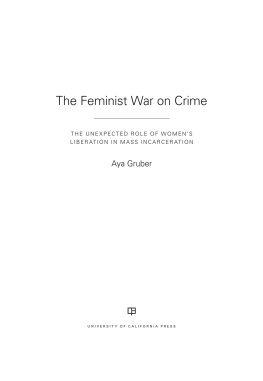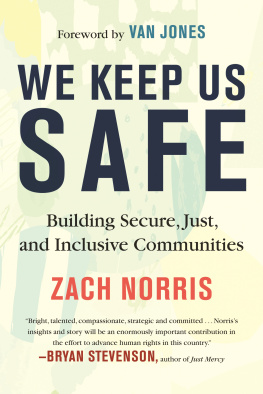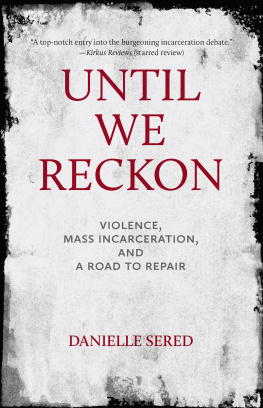Contents
Guide
Pagebreaks of the Print Version
IN THEIR NAMES
The Untold Story of Victims Rights, Mass Incarceration, and the Future of Public Safety
LENORE ANDERSON

NEW YORK
LONDON
To the remarkable leaders with whom I have partnered for the last decade and to the thousands of people who have joined together through tireless activism in pursuit of safety for all, I offer this book in your honor. You are organizers, experts, and advocates, but most of all, you are healershealing generations of harm caused by systems of neglect and dehumanization. My partnership with Robert Rooks is the foundation, and many other leaders, whose stories I share here, including Aswad Thomas, Tinisch Hollins, Shakyra Diaz, Aqeela Sherrills, David Guizar, Ingrid Archie, Adela Barajas, Jay Jordan, and many more, have worked alongside us for years, advocating for change in legislative hearing rooms, in front of television cameras, on the steps of state capitols, and on stages big and small. I hope this book does justice to your wisdom, power, and impact.
To Kioni, Nyame, Tehya, and Jael. May my generation do everything possible to make the world more safe and just for yours.
Contents
PART I A Marriage of Convenience
A Traumatized Nation
Aswad was twenty-six years old and two weeks away from moving across the Atlantic Ocean to start his basketball career in Europe when he woke up in a hospital bed and learned that he might never walk again. Eight hours earlier, on his way home, the recent college graduate had stopped at a convenience store in his neighborhood in Hartford, Connecticut. It was a warm summer night in 2009, and Aswad ran in to buy a bottle of orange juice. As he left the store, two young men holding guns appeared in front of him. They asked for his wallet. Aswad panicked and turned away. Instantly, he heard bangsnine shots, it would turn out. He felt himself falling.
Two of the nine bullets hit Aswad. One went through his left shoulder and tore across his back, and the other hit him in the lower back, lodging right next to his spine. Using the dwindling strength left in his arms, Aswad dragged himself along the concrete sidewalk and back into the store. He looked up at the terrified clerk, who was holding a phone. Then he passed out.
When he woke, Aswad found himself in a hospital bed with tubes running everywhere, into his body and all around him. His family stood by his bed with vacant, tear-filled gazes. He soon learned his lungs had collapsed, he couldnt talk or move his lower body, and his shoulder was shattered. The young basketball star lay in that hospital bed for ten days, swinging from feelings of shock and anxiety to extreme physical agony. Every eight hours, the nurses had to change the bandages on his shoulder and back. He had never felt such excruciating pain. Dr. Marshall, the physician who had performed emergency surgery on Aswad the night he was shot, visited him regularly to see how he was doing. Aswad was lucky, he said. When Aswad had arrived in the ambulance, the doctor was not sure he was going to make it. And, had the bullet to his lower back entered a razors edge closer to his spine, he could have been paralyzed. Aswad felt relieved to have survived and that he would walk again, but Dr. Marshall told him that the likelihood of ever playing basketball competitively was very slim.
Ten days later, Aswad was discharged from the hospital in a wheelchair, with a machine to help him breathe and a large plastic bag stuffed with four different types of medication and a stack of discharge papers. He had been shot just days before he was scheduled to start his post-college professional career overseas, and that meant he was unemployed and uninsured at the time. It also meant he did not have his own place to live. So, after he left the hospital, he stayed on the couch in the small apartment his mother shared with one of Aswads older brothers, not far from where the shooting took place. For many months, he rarely left that couch. He was in near-constant physical pain and was devastated by the drastic changes he faced. Every part of his life felt broken. How could he go outside again without being a target? How would he make a living? How could he avoid putting hardships on his family? The medical bills from the ambulance, emergency surgery, and hospital stay started piling up. And his Elms College student loanstens of thousands of dollarswould soon need to be paid as well.
Everything I worked toward was gone, Aswad recalled years after the shooting. Falling into debt, straining my mother, trying to figure out my new life. Whenever I moved, pain shot through my body. With every loud noise, I was flooded with adrenaline. Every time I closed my eyes, I was being shot again. Every time I opened my eyes, I was facing financial and emotional problems I couldnt easily solve.
Aswad suffered from chronic panic attacks, night sweats, and post-traumatic stress disorder. He could barely talk about the profound grief he was experiencing because he was worried how it might affect his already distraught family. A soft-spoken, earnest person and the youngest of five children who hates to burden others, he did not want to put too much emotional weight on his loved ones.
Interactions with the investigators on the criminal case added to Aswads distress: a battery of questions about what happened and about things he could not remember of the split seconds that changed everything. He felt as if every question implied it was his faulthis fault that it happened or his fault that he didnt recall much. The tone of condemnation and suspicion softened only when investigators found out about his promising basketball career that was cut short. Trips to the hospital were overwhelming too, made up of a long list of things he needed to do to heal his damaged body: medications, instructions, things to monitor, more appointments. He was traumatized and overwhelmed. That quick and seemingly inconsequential stop for orange juice had, in an instant, rerouted the path of his entire life.
The trauma and shock of an altered life that Aswad experienced is hard to fathomand a frighteningly common experience in the United States. At least one in four Americans become a victim of crime during the course of their lives, and more than half of these are victims of violent crime. This is likely an undercount.
Like Aswad, those who survive becoming a victim or losing a family member to a violent death are often plagued by a wide range of catastrophic repercussions in nearly every aspect of their lives, including traumatic stress. Health experts have uncovered the ways trauma can drastically interrupt well-being, often leading to a lifetime of negative consequences, including chronically poor health, economic instability, and early death. The documented experiences of crime survivors across the United States are proof of this. They report that trauma impedes a persons capacity to recover and regain stability in far-reaching dimensions, including losing the ability to maintain jobs or housing, struggling with family responsibilities or being unable to stay in school, coping with trauma by self-medicating with drugs or alcohol, and experiencing chronic levels of stress, hyperawareness, insomnia, exhaustion, dissociation, and hopelessness. Depression and anxiety arising from trauma also damage physical health, such as the development of ailments, including heart disease, diabetes, and other life-threatening maladies, creating additional lifelong burdens beyond the emotional and economic impacts. Multiply this by the millions who have been harmed by violence without getting recovery help and the picture of debilitating trauma begins to look like a national public health emergency. It is not an overstatement to say that the United States is a traumatized nation.







